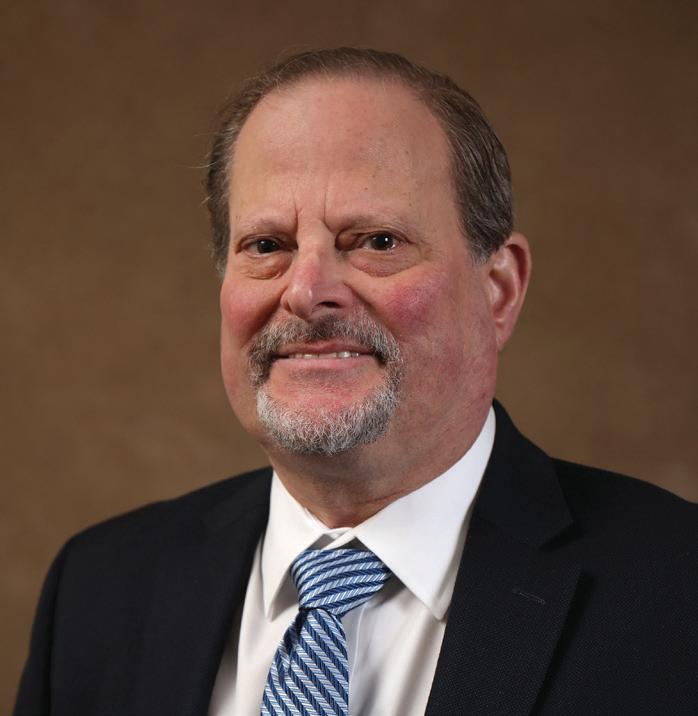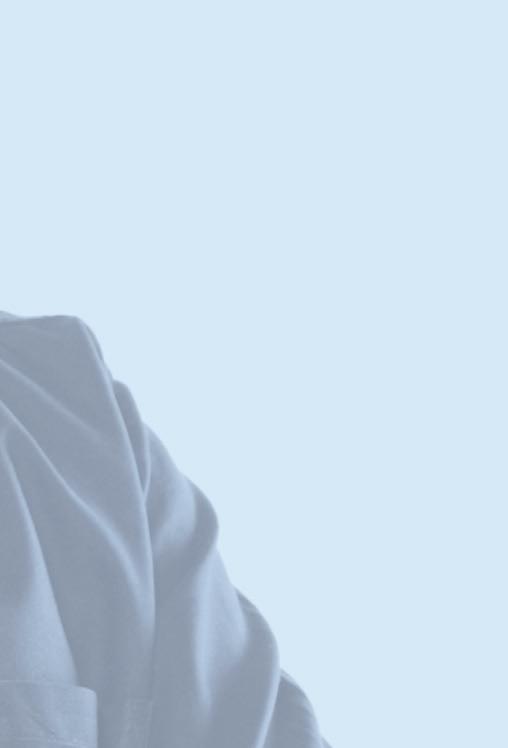
21 minute read
GETTING THE MOST OUT OF TELEHEALTH. Virtual visits
GETTING THE MOST OUT OF TELEHEALTH
VIRTUAL VISITS WON’T REPLACE IN-PERSON APPOINTMENTS, BUT THEY CAN PROVIDE SIGNIFICANT BENEFITS.
Not long ago, virtual doctor visits— appointments conducted via video or phone—were relatively rare. Now they’re commonplace, and they’re here to stay. “Th e pandemic gave telehealth a jump-start, but I believe it will become a permanent part of the healthcare delivery system,” says Andy Anderson, MD, President and Chief Executive Offi cer of the combined medical group of RWJBarnabas Health and Rutgers Health. “We are seeing ever-increasing use of our RWJBarnabas Health TeleMed services.” Telehealth can be used for primary and routine medical care, as well as for some aspects of specialty care. “Th ere’s still ANDY ANDERSON, MD enormous value in face-to-face appointments and physical examinations, and that will never go away,” says Dr. Anderson. “But telehealth has many uses, both for convenience and for making and maintaining the doctor-patient connection.” Here, he explains why.
Can a wellness visit be done through telehealth?
A good deal of preventive screening can be done this way. A doctor can ask, “Have you had your mammogram? Have you scheduled your colonoscopy? What kind of diet are you consuming? Are you sleeping well?” Patients can self-report their weight and, if they have a blood pressure cuff at home—as many patients do—their blood pressure numbers. A doctor can screen for cognitive issues, give referrals, advise on a plan for self-care and recommend future tests and appointments.
Telehealth is not, clearly, a full substitute for an in-person visit and
To learn more about RWJBarnabas Health TeleMed®, call 888.724.7123 or visit www.rwjbh.org/telemed.
examination. But it is a valuable way for people to get many of their healthcare needs met.
Besides wellness visits, what other kinds of primary care can be conducted virtually?
If you have an acute issue—for example, a cut or sprain, or a possible urinary tract infection—telehealth is a way to sort out the next steps, such as a doctor offi ce visit, trip to urgent care or a prescription.
Also, aspects of care for chronic conditions like diabetes, heart failure and high blood pressure can be managed via telehealth. A doctor can ask about blood sugar levels, about symptoms and about medication side eff ects. Th e physician can see certain symptoms over video, such as swelling in legs.
Chronic disease management should be done in a combination of in-person and telehealth visits. But many patients have been very happy to have routine check-ins take place in a video visit, sparing them time they’d have to spend traveling to the doctor’s offi ce.
When an in-person visit isn’t practical, why not just have a telephone call?
We encourage a video visit whenever possible, and fortunately, the technology for having one has become very simple to use. Th ere’s a huge visual component to communication—body language, expression. It’s important to see the patient and have them see you when you’re counseling or coaching them, or asking about side eff ects.
Are there any special issues for children?
For kids, much of their preventive care has to do with getting vaccines on schedule, so they’ll need in-person visits more than most adults.
Can telehealth be used for COVID-19 screening?
Absolutely. In fact, it’s a very important screening tool because, ideally, you don’t want a person to show up to a medical offi ce and potentially expose other people. An initial screening can be done eff ectively over the phone or via a video call by asking about the patient’s health history and symptoms. Th en prescriptions, tests or other next steps can be arranged as needed. Th e same is true, by the way, for people who have a bad cold or the fl u.
RWJBarnabas Health and Robert Wood Johnson University
EASING THE Hospital Hamilton, in partnership with Rutgers Cancer Institute of New Jersey—the state’s only NCI-Designated Comprehensive Cancer Center—provide “I Believe in Pink” founders Stacy Spera (center, photo at left, and left, photos above); Tracey Destribats (on Spera’s left, photo BURDEN OF close-to-home access to the most advanced treatment options. Call 844.CANCERNJ or visit at left, and center, photos above); and Denise Mariani (on Spera’s right, photo at left, and right, photos above). NOTE: These photos were
BREAST CANCER www.rwjbh.org/beatcancer. taken before mask and social distancing recommendations were in place.
was having trouble paying her rent. “We paid two months’ rent,” says German. The hospital “Breast cancer patients already have enough
Two years ago, Spera and Destribats PATIENTS IN NEED ARE RECEIVING FINANCIAL ASSISTANCE met with a nurse navigator at RWJUH Hamilton, and they agreed to raise funds FROM “I BELIEVE IN PINK,” A LOCAL NONPROFIT. for hospital patients. “I Believe in Pink”
Worrying about finances when stress and worries, so if we can help improve RWJUH Hamilton for items such as wigs, you’re fighting for your life their outcome or quality of life, we’re happy turbans, headscarves, food, gas and rent. “It is the last thing you want to to do that,” says German. was a win-win,” recalls Spera, who works do. But for some breast cancer patients, as Chief of Operations at New Jersey’s that’s the reality. To the rescue: “I Believe in HELPING THE NEEDIEST Department of Community Affairs. Pink,” a nonprofit group that partners with PATIENTS Several local businesses have provided Robert Wood Johnson University Hospital “I Believe in Pink” was launched in 2018 funds for “I Believe in Pink,” and there’s a (RWJUH) Hamilton to help breast cancer by Stacy Spera, a breast cancer survivor, fundraising event every year. In 2018, the patients in need. Recently, the organization and her best friend, Tracey Destribats, organization held a “Hats Off to Breast helped pay for a patient’s hormone therapy. a local bakery owner. Local attorney Cancer” event, in which attendees wore “She was taking the drug every other day Denise Mariani was also instrumental in their favorite hats. Last year, the event was because she couldn’t afford the out-of-pocket forming the organization. The mission was called “Let’s Tackle Breast Cancer,” and the cost,” says Amy German, Director, Cancer established after Spera received a $900 bill organization sold football shirts to guests. Center, RWJUH Hamilton. “We were able for a compression bra, which is used to treat In total, the organization has raised $20,000 to pay the difference, helping to prevent lymphedema, in which swelling occurs as a for RWJUH Hamilton patients. “Patients her chances of a recurrence.” The hospital result of the removal of lymph nodes. The are humbled and touched by any kind of was also able to purchase a chair lift for a bra was covered by Spera’s insurance, but support we give them,” says German, who patient with an aggressive form of breast she wondered how people who don’t have notes that there have been more requests cancer who was too weak to get to the second insurance can afford items like this. “We for financial assistance since the COVID-19 floor of her home. Another patient with wanted to start an organization to help the pandemic began. “We want to give them the advanced breast cancer had lost her job and neediest patients,” says Spera. best chance for a positive outcome.” has also provided transportation for patients For more information about “I Believe in Pink,” visit www.Ibelieveinpink.org. who need a ride to treatment appointments. To support the hospital, visit www.rwjbh.org/hamiltongivenow. donated the first $10,000 it raised to






THANKS TO SPINE SURGERY, A PHYSICIAN IS BACK TO PLAYING GOLF AND CAN WALK WITHOUT PAIN.
In the summer of 2019, Robert Silverbrook, DO, an internist with RWJBarnabas Health Medical Group, was suffering from debilitating back and leg pain. He had to drive down his driveway to get his mail because it was too painful to walk. When he went to work, he always had to worry about finding a parking spot close to the door. When he visited his children in another state, he had to stop at rest stops because he couldn’t sit for long. “I was in pain every minute, and I was becoming more and more inactive,” recalls Dr. Silverbrook. “The discomfort radiated down my back into my left thigh below my knee. I took anti-inflammatory medications, but I knew I needed surgery.”
Unfortunately, this wouldn’t be his first spine surgery. Dr. Silverbrook had already had four procedures. The most recent one, a discectomy—in which a herniated or bulging spinal disk is removed to relieve pressure on the spinal cord—was done in 2018. Initially, he experienced relief from the pain, but it didn’t last long. He tried cortisone injections and physical therapy, but neither helped.
Dr. Silverbrook had previously worked with Erol Veznedaroglu, MD, a neurosurgeon at The Center for Neurosciences at Robert Wood Johnson University Hospital (RWJUH) Hamilton, so he contacted him. Dr. Veznedaroglu recommended that Dr. Silverbrook see his partner, Zakaria Hakma, MD, FACS, FAANS, Section Chief, Neurosurgery, RWJUH Hamilton, and a minimally invasive spine surgery specialist. “Over time, Dr. Silverbrook had developed a very high tolerance for pain,” says Dr. Hakma. “For him to complain and seek another surgical opinion indicated that he suffered from quite a bit of discomfort.”
A COMPLICATED PROCEDURE
An MRI of Dr. Silverbrook’s lumbar spine revealed that he had what’s known
as “adjacent segment disease,” which can develop as a result of spinal fusion surgery or degenerative changes in the spine. When spinal segments—composed of an intervertebral disc, vertebrae above and below the disc, joints and ligaments—are fused during surgery, they no longer move. As a result, the healthy adjacent segments move more, and they become stressed. This can lead to degenerative disorders in the spine, such as herniated discs and osteoarthritis. In Dr. Silverbrook’s case, he also had spondylolisthesis, in which a spinal bone (vertebra) slips forward, causing back and leg pain.
Dr. Silverbrook needed another procedure to remove damaged spinal discs. He also needed surgery to remove facet joints, which compress nerve roots
Spine surgeon Zakaria Hakma, MD, Section Chief, Neurosurgery, prepares for a procedure. Left: Robert Silverbrook, DO, an internist with RWJBarnabas Health Medical Group, benefited from Dr.
Hakma’s expertise.


when they’re damaged or degenerated, and the bony “roof” of the spinal canal. The goal was to relieve pressure on spinal nerves. Afterward, Dr. Hakma would use bone graft material and screws to stabilize Dr. Silverbrook’s spine. Dr. Silverbrook was confident in Dr. Hakma’s expertise. In addition, “He has a calming presence,” he says.
A SUCCESSFUL OUTCOME
Dr. Silverbrook had surgery on January 29 at RWJUH Hamilton, and it went smoothly. Three neurosurgeons, including his former coworker, Dr. Veznedaroglu, performed the procedure. “Multiple previous surgeries and old hardware required us to perform an open procedure,” says Dr. Hakma. The night of the surgery, Dr. Silverbrook was able to walk the hallways of the hospital. “I was sore, but I didn’t have pain in my back or leg,” he says. He spent two days in the hospital. “The care on the orthopedic floor was tremendous,” he says. “The nurses were very attentive.”
About one week after the surgery, Dr. Silverbrook was able to walk to his mailbox. Two weeks later, he was able to go to the grocery store and carry light bags (around five pounds each). During his recovery, Dr. Silverbrook worked with a trainer. On March 1, he returned to work. “The procedure was successful,” he says. “My goal was to be able to walk a mile without any leg pain and play golf. Now I can golf, swim and walk without any pain. This surgery has given me my life back. It’s hopefully my last one.”
Learn more about The Center for Neurosciences at Robert Wood Johnson University Hospital Hamilton at www.rwjbh.org/hamiltonneuro.
LOSE WEIGHT, LIVE LONGER



THE BARIATRIC PROGRAM OFFERS SAFE AND EFFECTIVE WAYS TO SLIM DOWN.

About 42 percent of adults in the U.S. are obese, according to the National Health and Nutrition Examination Survey. Th at’s alarming, because being overweight increases the risk of dying from COVID-19—especially in people age 60 or younger and in men, according to a study published in the Annals of Internal Medicine. One possible explanation: COVID-19 causes breathing diffi culties, and obesity exacerbates RAGUI SADEK, MD the problem. Also,


people who are obese have more trouble recovering from respiratory infections like pneumonia.
People with a body mass index (BMI)—a weight-height ratio—over 40 live 10 fewer years than those who have a lower BMI, according to Ragui Sadek, MD, Director, Metabolic and Bariatric Surgery, Robert Wood Johnson University Hospital (RWJUH) Hamilton. Obesity can lead to heart disease, diabetes and uterine, esophageal and colorectal cancers. For people with high BMIs, “the cure is surgery,” says Dr. Sadek. “It has proven success based on the literature.”
At RWJUH Hamilton, the Bariatric Program provides advanced treatment for weight loss. Program physicians perform primary surgeries as well as revision surgeries using robotic technology. Th ere are six surgeons, a physician assistant, a nurse and a dietitian. Patients see a nutritionist, psychologist, cardiologist, pulmonologist and gastroenterologist prior to surgery, says Dr. Sadek. Th e psychologist evaluates patients for behavioral health problems like eating disorders, which can interfere with the outcome of surgery. A cardiologist ensures patients can tolerate surgery. A pulmonologist, who specializes in lung conditions, rules out conditions like sleep apnea. A gastroenterologist checks patients for ulcers, untreated infections, hernias and refl ux. “We use cutting-edge research to improve our outcomes,” says Dr. Sadek.
TYPES OF BARIATRIC SURGERY
The weight-loss procedure that’s right for you depends on several factors, such as your age, eating habits, long-term goals and medical problems, such as diabetes, says Ragui Sadek, MD, Director of Metabolic and Bariatric Surgery at Robert Wood Johnson University Hospital (RWJUH) Hamilton. Talk with Robert Wood Johnson University Hospital (RWJUH) Hamilton. Talk with your physician about which procedure would work best for you. your physician about which procedure would work best for you.
• SLEEVE GASTRECTOMY
HOW IT WORKS: About 80 percent of the stomach is removed, leaving a small “sleeve” about the size of a banana. This surgery leaving a small “sleeve” about the size of a banana. This surgery helps people feel full after eating small amounts of food and helps people feel full after eating small amounts of food and causes gut hormone levels to drop so they’re not as hungry. causes gut hormone levels to drop so they’re not as hungry. BEST FOR: BEST FOR: It’s great for people who feel hungry all the time because it prevents them from overeating. It also helps to resolve serious health conditions like diabetes. People who have gastroesophageal refl ux conditions like diabetes. People who have gastroesophageal refl ux disease should avoid this procedure, though, because it can worsen disease should avoid this procedure, though, because it can worsen the problem. the problem.
• GASTRIC BYPASS
HOW IT WORKS: The stomach is divided into two sections. The top part becomes a small pouch the size of a golf ball. It limits top part becomes a small pouch the size of a golf ball. It limits the amount of food that can be eaten. The stomach is connected the amount of food that can be eaten. The stomach is connected to the middle of the small intestine, and the remaining parts of the to the middle of the small intestine, and the remaining parts of the stomach and intestinal tract don’t absorb food. This procedure leads to stomach and intestinal tract don’t absorb food. This procedure leads to hormonal changes that promote weight loss. BEST FOR: BEST FOR: This procedure is ideal for people with severe diabetes because it cures the condition. It also prevents people from because it cures the condition. It also prevents people from overeating. It can benefi t those with refl ux disease. overeating. It can benefi t those with refl ux disease.
• DUODENAL SWITCH AND SINGLE-ANASTOMOSIS DUODENAL ILEAL BYPASS WITH SLEEVE GASTRECTOMY (SADI-S)
HOW IT WORKS: This is a modifi ed duodenal switch procedure. A portion of the stomach is removed to create a smaller one. Next, A portion of the stomach is removed to create a smaller one. Next, a large part of the small intestine, or duodenum, is bypassed so a large part of the small intestine, or duodenum, is bypassed so that food empties into the last segment of it, resulting in less absorption of calories and nutrients. The new version, called SADI-S, is a shorter, less complicated operation and has a lower risk of long-term nutritional defi ciencies. The procedure helps to reduce the amount of food a person eats and reduces the absorption of fat. It also results in hormonal changes that reduce appetite and lead to a feeling of “fullness.” BEST FOR: This procedure results in the most weight loss. People with high BMIs or long-standing diabetes that’s diffi cult to control can benefi t.
BEST CANDIDATES
To qualify for bariatric surgery, you must have: • a body mass index (BMI) of 40 or greater • a BMI of 35 to 40 plus one or more other conditions, such as Type 2 diabetes, high blood pressure, sleep apnea, high cholesterol or an enlarged liver
A BARIATRIC SURGEON ANSWERS YOUR QUESTIONS
What is your vision for the Bariatric Program at Robert Wood Johnson University Hospital (RWJUH) Hamilton?
We want to bring a high-quality program to RWJUH Hamilton. Our program at RWJUH Hamilton’s sister hospital, Robert Wood Johnson University Hospital, has been one of the top in the state and is ranked nationwide for its quality, standards and success rates.
What’s an accredited program?
RWJUH Hamilton’s bariatric surgery program is a Center of Excellence for Metabolic and Bariatric Surgery. That means it’s accredited by the Metabolic and Bariatric Surgery Accreditation and Quality Improvement Program (MBSAQIP), a joint venture between the American College of Surgeons and the American Society for Metabolic and Bariatric Surgery. Bariatric surgery centers must meet certain practice standards in order to be accredited. They also must report their surgical outcomes to the MBSAQIP database.
What’s unique about the program at RWJUH Hamilton?
We offer high-quality patient care. Also, we use the most advanced equipment to perform weightloss surgery safely. We perform minimally invasive procedures using robotic technology.
Schedule an appointment today and begin your journey to a healthier life. Call 888.124.7123 or visit www.rwjbh.org/weightloss.
LIFESAVING SCREENINGS FOR MEN



WHY IT PAYS TO STAY ON TRACK WITH ROUTINE MEDICAL TESTS.

Many people put off medical care—especially men. Th at’s risky. Taking the time to see your doctor for routine screening tests can have a big health payoff . “When conditions are found earlier, they can be easier to treat,” says Shankar Santhanam, MD, a family physician and chair of the
Department of Family Practice at Robert
Wood Johnson University Hospital
Hamilton. Men should schedule the following screenings at these ages, according to Dr. Santhanam:
STARTING AT AGE 18
• BLOOD PRESSURE Check it at least once every two years. If your systolic blood pressure (upper number) is between 120 and 129 mm Hg and your diastolic blood pressure (lower number) is less than 80 mm Hg, your blood pressure is elevated and you should get it checked annually. High blood pressure is defined as a reading that’s higher than 140/90 mm Hg. Before starting treatment, be sure to obtain measurements outside the doctor’s office. • CHOLESTEROL Unless your readings are abnormal, this blood test should be performed every five years. Total cholesterol should be less than 200 mg/ dL; LDL, or “bad” cholesterol, should stay under 100 mg/dL; and HDL, or “good” cholesterol, should be 60 mg/ dL or higher. An HDL reading below 40 is considered a cardiac risk factor. High levels of “bad” LDL cholesterol can increase your risk of developing heart disease, while high levels of “good” HDL cholesterol can lower it. • DIABETES Screening is only advised if you have risk factors, such as a body mass index (BMI) of 25 or greater; blood pressure of 140/80 mm Hg or higher; and other risk factors, such as a family history of SHANKAR SANTHANAM, MD diabetes. Normal blood sugar levels are up to 99 mg/dL after fasting or 140 mg/ dL two hours after eating. • TESTICULAR CANCER Testicular cancer is the most common malignancy in young men; it often strikes in the 30s. During a routine checkup, a physician typically performs an exam. Men with risk factors—such as a family history of the disease or an undescended testicle—should consider performing selfexams on a monthly basis. • SKIN SELF-EXAMS There are no standard guidelines for early detection of skin cancer, but many doctors recommend monthly self-exams, according to the American Cancer Society. They’re especially important if you’re at risk of skin cancer due to a personal or family history of the disease or if you have a compromised immune system.
AGES 40 TO 64
• COLORECTAL CANCER In 2018, the American Cancer Society recommended that people begin screening at age 45 instead of 50 due to the increase in younger individuals being diagnosed with the disease. You might need to be screened even earlier if you have risk factors, such as a family history of colorectal cancer or polyps or inflammatory bowel disease. Screening can involve annual stool-based tests; sigmoidoscopy every five years; or colonoscopy every 10 years. You may need to be tested more often depending on your risk factors. • PROSTATE CANCER Men over 50 should discuss prostate cancer screening with their doctor, says Dr. Santhanam. The benefits of having a routine screening blood test that measures PSA (prostate-specific antigen) have not been shown to outweigh the risks. Some men experience false-positive test results that may require more testing and possibly a biopsy. However, African-American men and those who have a family member who was diagnosed with prostate cancer before age 65 should consider PSA testing starting at age 45. • LUNG CANCER Annual screening with low-dose CT scans is recommended for people between the ages of 55 and 80 who have smoked one pack of cigarettes per day for 30 years or two packs per day for 15 years. Most insurance covers this screening if you meet additional criteria, such as being a current smoker or have quit in the last 15 years. • OSTEOPOROSIS If you’re over 50, discuss screening with your healthcare provider. You might benefit from bone density testing if you smoke, have used steroids for a long time, drink heavily or broke a bone after age 50.
AFTER AGE 65
• ABDOMINAL AORTIC ANEURYSM If you’re a former smoker and are between the ages of 65 and 75, consider having an ultrasound, which detects this potentially deadly bulging in the aorta, the body’s main artery. Otherwise, ask your healthcare provider if you could benefit from this test. • ELECTROCARDIOGRAM (EKG) Starting at age 65, have an EKG annually, advises Dr. Santhanam. EKGs measure the heart’s electrical activity and can detect irregularities, which can signal heart disease. Men with a personal or family history of heart disease, diabetes or high blood pressure should consider having an EKG starting at age 40, says Dr. Santhanam.
To schedule an appointment with a Robert Wood Johnson University Hospital Hamilton primary care physician, call 855.571.2500.
1 Hamilton Health Place Hamilton, NJ 08690
NONPROFIT U.S. POSTAGE PAID Lebanon Junction, KY PERMIT #799
Y our back. Now without pain.

Solutions for back and neck pain don’t always start with surgery. But at Robert Wood Johnson


University Hospital Hamilton, solutions start with an objective diagnosis by qualified experts. Our fellowship-trained spinal surgeons understand the complexities of the spine, assuring you a thorough understanding of your condition and the treatment options available. Whether that means an individualized physical therapy plan or a minimally invasive spinal procedure, you can be certain of two things: a solution that’s right for you and one that’s been recommended by the region’s only hospital nationally certified by the Joint Commission in spine surgery. Schedule


your evaluation at rwjbh.org/hamiltonortho









